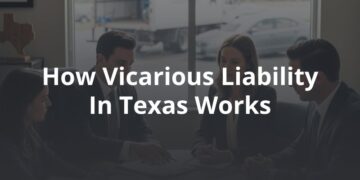
Many states have damage cap laws that limit the amount of financial compensation a personal injury plaintiff can recover through a claim. While Texas has caps on pain and suffering damages in specific types of cases, car accidents are generally not one of them. There are no state-imposed caps on non-economic damages in car accident cases – allowing victims to recover the full amount of pain and suffering damages they need.
Texas’s Damage Caps
A car accident can significantly disrupt a victim’s life, causing painful and serious injuries, expensive medical costs, and inconvenient property damage. Texas law permits victims to seek financial compensation for all of these losses from the at-fault party in the aftermath of an automobile accident.
This financial recovery is meant to make the victim whole again and hold the negligent party accountable. Financial compensation given to a plaintiff for pain and suffering is only capped or limited in Texas in two types of cases: medical malpractice and claims against the government.
Medical Malpractice Damage Caps
Texas Civil Practice and Remedies Code § 74.301 caps non-economic damages in malpractice claims brought against health care institutions, including physicians and other medical providers. This law limits pain and suffering damages to $250,000 per claimant and $500,000 per claim.
Punitive damages are also capped in medical malpractice claims at the greater of $200,000 or twice the amount of economic damages plus non-economic damages (up to $750,000).
Caps on Claims Against the Government
If a car accident or another type of harmful incident is caused by a government agency or one of its on-duty employees, Texas law (the Texas Tort Claims Act) caps damages. These caps apply to the entire financial recovery, including pain and suffering damages.
Available compensation is limited to $250,000 per person and $500,000 per event if the claim is against the state government, and $100,000 per person and $300,000 per event if it’s against the local government.
| Level of Government | Maximum Per Person | Maximum Per Event |
|---|---|---|
| State Government | $250,000 | $500,000 |
| Local Government | $100,000 | $300,000 |
What Is Included in a Pain and Suffering Damage Award?
Pain and suffering in a Texas car accident case refers to the losses suffered by the victim that are not financial or monetary in nature. They address the intangible, non-economic losses caused by the car crash.
Pain and suffering can refer to a range of physical discomfort and emotional stress a victim endures as a result of a car accident. This may include:
- Physical pain (immediate and long-term)
- Emotional distress
- Mental anguish
- Permanent scarring, disfigurement or disability
- Psychological impacts
- Post-traumatic stress disorder (PTSD)
- New phobia of driving
- Anxiety or depression
- Loss of enjoyment of life
- Loss of consortium
The recovery of non-economic damages is permitted in Texas car accident lawsuits in an effort to make the victim whole again – not just by replacing tangible losses such as the price of medical bills, lost wages and property damage, but the victim’s individual suffering, as well. These damages are awarded to make up for the true nature of the victim’s ordeal.
How Is Pain and Suffering Calculated in a Car Accident Lawsuit?
Economic or financial damages in a car accident case are calculated using numbers pulled directly from relevant documents, such as medical bills, property repair estimates and lost wage statements. Future foreseeable economic damages are determined with help from expert witnesses such as accountants and life-care planners.
Pain and suffering damages, on the other hand, are subjective. This makes them more difficult to calculate. Financial compensation awarded for non-economic damages is typically determined based on the nature of the victim’s injuries and how significantly they have impacted his or her life.
An insurance company, judge or jury does not have to use any one specific equation to calculate pain and suffering. They have the right to assign a value they see fit based on the facts provided. However, most rely on one of two main methods to determine a fair amount in non-economic damages.
The Multiplier Method
This is the most common method used, especially if a car accident case involves severe, long-term or catastrophic injuries. The Multiplier Method takes the amount of economic damages awarded to a car accident victim and multiplies it by a number between 1.5 and 5 to determine non-economic damages.
The multiplier is decided based on the severity of the victim’s injuries. In general, catastrophic car accident injuries will receive a higher multiplier than mild to moderate injuries.
The Per Diem Method
The Per Diem Method is a different valuation that is used more often in cases where the victim has a clear date of maximum medical improvement or recovery. This method assigns a daily dollar amount (often equivalent to the victim’s daily wage) and multiplies it by the number of days the victim is expected to endure pain and suffering from the accident or injury.
Are There Damage Caps on Wrongful Death Lawsuits?
Texas does not have a specific cap on damages in wrongful death cases. However, punitive damages are capped at $750,000 or twice the amount of economic damages, whichever is greater. Punitive damages in a car accident case are intended to punish a defendant for egregious acts of wrongdoing, such as reckless driving, drunk driving, gross negligence or vehicular manslaughter.
How to Maximize Your Recovery for Pain and Suffering
You may experience significant pain and suffering as a car accident victim in Texas. Use the following general tips to improve your odds of securing maximum financial compensation for your intangible losses:
- Gather evidence. Take pictures of your injuries as they heal. Write down a daily update of how you feel in an injury journal.
- Stay off of social media. Don’t post anything on social media sites, as an insurance company could use this against you to argue that you have not suffered diminished enjoyment of life.
- Hire a car accident attorney. An experienced attorney can help make you whole again with advanced knowledge of insurance company tactics, settlement negotiation expertise, litigation preparedness and prompt evidence collection.
- Use medical experts. With help from a lawyer, you can hire expert witnesses who clearly demonstrate the severity of your injuries and their impact on your life and future to an insurer or the courts.
To receive personalized legal advice and guidance for your car accident claim in Texas, contact FVF Law Firm for a no-cost, no-pressure consultation. Our Austin personal injury lawyers have more than 100 years of combined experience and are prepared to help you in every way that we can.







